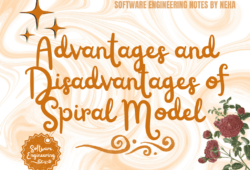Iterative Waterfall Model
 Posted On
Posted On
Iterative Waterfall Model:
Iterative waterfall model is similar to classical waterfall model. The iterative model can be viewed by making necessary changes to the classical model to make it applicable for practical software development projects.
The iterative waterfall model provides feedback paths from every phase to its preceding phases, which is the main difference from the classical waterfall model.
The Iterative Waterfall Model is a software development approach that combines the sequential steps of the traditional Waterfall Model with the flexibility of iterative design.

All the phases of Iterative Waterfall Model in Software Life Cycle Model (SDLC) are almost the same as they were in the classical waterfall model.
The waterfall model is a linear SDLC model whereas the iterative model is cyclical in nature.
Once the initial requirement planning process is completed, some of the other stages are repeated.
All the phases of Iterative Waterfall Model in Software Life Cycle Model (SDLC) are almost the same as they were in the classical waterfall model.
The waterfall model is a linear SDLC model whereas the iterative model is cyclical in nature.
Once the initial requirement planning process is completed, some of the other stages are repeated.
1. System Study/Requirement Analysis:
System study is the first stage of system development life cycle. System study is performed the problem which the proposed system is to solve.
2. Feasibility Study:
The feasibility study is basically the test of the proposed system in the light of its workability, meeting user’s requirements, effective use of resources and the cost effectiveness.
The various types of Feasibility Study:
- Technical Feasibility
- Operational Feasibility
- Economic Feasibility
a. Technical Feasibility:
It involves determining whether or not system can actually be constructed to solve the problem. It includes following question like.
- Does the necessary technology exist to do?
- Can the system be expanded, if developed?
b. Operational Feasibility:
The willingness and ability of the management, employees, customer and suppliers to use and support the proposed system comes under operational feasibility.
c. Economic Feasibility:
It involves estimating benefits and costs. It includes the following questions:
- The cost to construct a full system.
- The cost of hardware and software.
3. System Analysis:
Analysis involved a detailed study of the current system, leading to specifications of a new system. Analysis is a detailed study of various operations performed by a system and their relationships within and outside the system.
4. System Design:
Based on the user requirements and the detailed analysis of a new system, the new system must be designed. This is the phase of system designing. It is a most crucial phase in the development of the system.
The two stages of System design:
- Preliminary or general design
- Structure or detailed design
5. Coding:
After designing the new system, the whole system is required to be converted into computer understandable language. Coding is the process of developing the software for the proposed system using some computer programming language.
6. Testing:
These are techniques available for detecting and eliminating errors that originate in various stages. Testing phase is an important phase of successful system.
Using the test data following test run are carried out:
- Unit Test
- System Test
7. Implementation:
During this phase, all the programs of the system are loaded onto the user’s computer. After loading the system, training of the user’s starts.
Main topics of such type of training are:
- How to execute the package.
- How to enter the data.
- How to process the data.
- How to take out the reports.
8. Maintenance:
Maintenance is necessary to eliminate errors in the system during its working. It also means the review of the system from time to time.
The review of the system is done for:
- Knowing the full capabilities of the system.
- Knowing the required changes or the additional requirements.
- Studying the performance.


